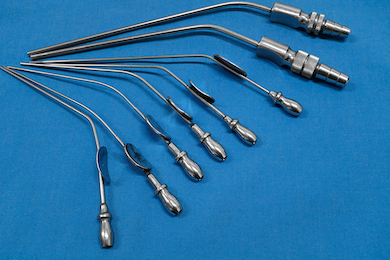Treatments: Ear Wax (Cerumen)
Normally, ear wax serves a purpose: it helps protect the ear canal from infection and water. If wax is not causing a problem, it is best to ignore it. Individuals with medical problems from wax, such as hearing loss or infection in the wax itself, there are some recommended and other not recommended ways of removing it.
what not to do for wax, and why!
Use of Q-tips (cotton buds), hair pins, pen caps, etc., and candling are dangerous and should never be performed. Q-tips tend to remove only some of the wax present, pushing remaining wax deeper in the ear canal. If this wax is pressed up against the eardrum, hearing loss occurs. Some of the cotton from a Q-tip also stays behind, mixing with the wax to create a tough matrix. Foreign bodies are also prone to causing trauma. People are often unaware of how deep they are putting an object in the ear canal, which can lead to significant trauma.
Using a liquid, such as hydrogen peroxide, in the ear should only be done if there is no hole or tear in the ear drum.
The simplest form of wax management: Ignore it.
For the vast majority of people, earwax does not cause symptoms and it falls out on its own. This is the simplest, safest, cheapest, and easiest way to manage earwax. Removal of earwax should only be undertaken if it is causing symptoms or preventing a physician from conducting a necessary ear examination.
Another option: soap, water, & dry air
If one is sure there is no hole (perforation) in the eardrum, washing the ears with soap or shampoo with a gentle rinse at every shower or bath is an effective, easy, and low risk option. Using a blow drier pointed at the ears after bathing dries the ear canal to avoid skin maceration and infection.
Dissolving wax
If the above is insufficient in managing wax, it may be best to verify the problem to be truly wax and not a different medical condition. If wax is confirmed by your physician, and there is no perforation or tube in the eardrum, then they may suggest adding a few drops of standard (3%) hydrogen peroxide or Debrox to the ear canal using a medicine dropper before showering. With one ear tilted up toward the ceiling, drops may be placed in the ear canal and then massaged in by repeatedly pressing on the tragal cartilage in front of the ear canal. After holding this position for a moment, the process may be repeated on the other ear. Some people place drops prior to showering, during which time they implement the soap, water, and dry air technique described above.
Some physicians recommend applying mineral oil or olive oil to the ear canals to soften the wax and allow it to break up.
Ear irrigation
More commonly performed in the office of a non-ear, nose, and throat physician, some doctors will flush out the ear canal with water. While this often works, concern for unintentional damage to the ear from excessive pressure leads most ENT doctors to favor other techniques readily available to them. Performing this on oneself has the additional disadvantage of not being able to visualize the ear canal before and after irrigation.
removal of wax in an Ear, nose, and throat office
If the above measures do not resolve the problem, an ear, nose, and throat office is equipped to remove the wax through a combination of techniques. Using a magnifying lens, wax may be suctioned out or removed with ear instruments in the office. In children or individuals who cannot tolerate wax removal in the office, performing the procedure in the operating room is an option.
Guidelines for wax management for hearing aid users:
Hearing aid users should have regular ear canal checks every 3 to 6 months.
The wax trap in receiver-in-canal, completely-in-the-canal, in-the-canal, and in-the-ear hearing aids should be cleaned.
Replace the wax trap once per 3 months and whenever hearing aid is not working.
Behind-the-ear hearing aids users should detach the earmold from the hearing aid one hearing aid at a time to avoid accidentally placing a mold on the wrong hearing aid.
Once the earmold is detached, soak it in mild soapy solution; do not use isopropyl alcohol, solvents. or oils to clean earmolds.
Clean the earmold, and rinse with water.
Dry the earmold, and remove any excess moisture or debris.
If earmolds cannot be detached, wipe with a damp cloth to remove any visible earwax, or use a soft toothbrush or the brush provided with the hearing aids.
Check the earmold tube to be sure that it is clear before reattaching to hearing aid. If the tube is clogged, have it replaced by your audiologist.
Placing a hearing aid in an ear canal with hydrogen peroxide in it may damage the hearing aid.
Guidelines for wax management with a perforation (hole) in the eardrum, with or without a tympanostomy (pressure equalization) tube in place:
Water and other liquids should not be allowed in the ear canal when the eardrum has a perforation
An exception is chlorinated swimming pool water. It is generally safe to swim in a chlorinated pool with an eardrum perforation
Other forms of water (especially lake or ocean water) have bacteria that can pass through the perforation and cause middle ear infection (otitis media)
Ear irrigation is not advisable with an eardrum perforation.
Solutions such as hydrogen peroxide, Debrox, and oils should not be used, as they can cause problems if they pass through the perforation
If the accumulation of earwax causes a problem, its removal by an ENT physician may be necessary.
This page













